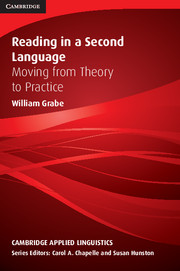Book contents
- Frontmatter
- Contents
- Series editors' preface
- Preface
- I FOUNDATIONS OF READING
- II PATTERNS OF VARIATION IN READING
- Chapter 6 Reading in different languages
- Chapter 7 L1 and L2 reading relationships
- Chapter 8 The social contexts of reading
- Chapter 9 Motivation for reading
- III DEVELOPING READING COMPREHENSION ABILITIES
- IV EXPANDING READING COMPREHENSION SKILLS
- References
- Author Index
- Subject Index
Chapter 7 - L1 and L2 reading relationships
from II - PATTERNS OF VARIATION IN READING
Published online by Cambridge University Press: 05 August 2012
- Frontmatter
- Contents
- Series editors' preface
- Preface
- I FOUNDATIONS OF READING
- II PATTERNS OF VARIATION IN READING
- Chapter 6 Reading in different languages
- Chapter 7 L1 and L2 reading relationships
- Chapter 8 The social contexts of reading
- Chapter 9 Motivation for reading
- III DEVELOPING READING COMPREHENSION ABILITIES
- IV EXPANDING READING COMPREHENSION SKILLS
- References
- Author Index
- Subject Index
Summary
Unlike first language reading, second language reading involves two languages. The dual-language involvement implies continual interactions between the two languages as well as incessant adjustments in accommodating the disparate demands each language imposes. For this reason, L2 reading is crosslinguistic and, thus, inherently more complex than L1 reading.
(Koda, 2007: 1)Chapter 6 emphasized the potential role of L1 transfer effects on L2 reading abilities, with an emphasis on word-recognition issues. This chapter explores the various factors influencing L2 reading development, describing L1–L2 differences in reading development and the impact of L1 transfer on L2 reading. L2 reading development is not simply the result of L1 transfer. In fact, most issues in L2 reading development can be associated more with the development of L2 language proficiency, L2 language exposure, L2 print exposure, and L2 processing-skills development, and these differences are addressed in the first half of the chapter. Nonetheless, L1 transfer has an important role to play, and research on its role has been evolving in the past decade toward a view of “learning to read with languages.”
L2 reading is an ability that combines L2 and L1 reading resources into a dual-language processing system. Cook (1997; Cook & Bassetti, 2005a) describes this interaction of L1 and L2 systems as multicompetence. Koda (2007) refers to crosslinguistic interactions to capture the concept of an L2 reading system in which “the transferred competencies will continue to mature through experience with L2 print input” (p. 18) (see also Bialystok, 2001, 2002).
- Type
- Chapter
- Information
- Reading in a Second LanguageMoving from Theory to Practice, pp. 129 - 151Publisher: Cambridge University PressPrint publication year: 2008



